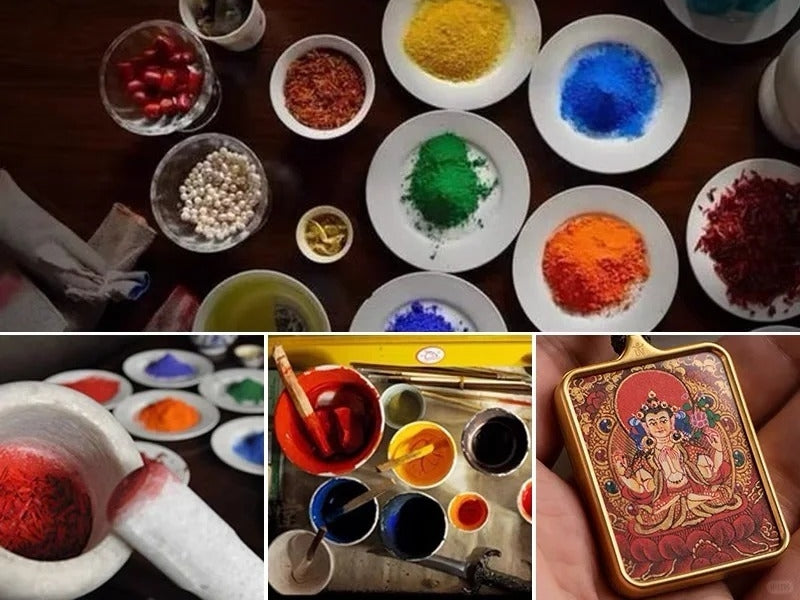Tibetan silverwork is beautiful and full of cultural meaning, but the term “Tibetan silver” covers a wide range of materials and techniques. This primer will help you tell the difference between traditional alloys and modern S925 sterling, recognize hallmarks and regional styles, read patina and repairs, and make ethical choices when buying or caring for Himalayan silver pieces.
What people mean by “Tibetan silver”
-
Traditional Tibetan silver often refers to regionally made alloys — blends of silver with copper, zinc, or other base metals — used historically by Himalayan silversmiths. These alloys were practical, durable, and easier to work with when pure silver was scarce.
-
Modern sterling (S925) is a standardized alloy: 92.5% silver, 7.5% typically copper. Contemporary Tibetan-style pieces sold internationally are increasingly made in S925 and clearly stamped as such.
Knowing this distinction matters because it affects value, care, and what to expect from wear and repair.

Hallmarks and stamps: what to look for
-
S925 / .925 / 925: Clear sign the piece is sterling silver. This is the easiest non-destructive identifier for modern pieces.
-
Maker’s marks or workshop stamps: Small pictorial or character stamps—sometimes Tibetan script or a simple maker’s logo—indicate artisan or workshop origin. These are common on authentic regional pieces but aren’t standardized.
-
Absence of marks: Many older or locally made pieces lack any assay marks. No hallmark doesn’t automatically mean “fake”; it may simply be an unassayed, traditionally made object.
-
Misleading marks warning: Be cautious if a piece claims to be “antique Tibetan silver” but bears a modern mass-producer’s hallmark or an obviously machine-made finish.
Visual and tactile clues to authenticity
-
Handmade signs: Slight asymmetry, irregular tool marks, and tiny variations in pattern usually indicate handwork (lost-wax casting, repoussé, chasing).
-
Perfect symmetry and machine finish: Uniformity, perfectly repeated patterns, or identical pieces in quantity suggest machine production.
-
Weight and sound: Solid silver alloys feel substantial. A gentle “ping” on a small piece (not recommended for fragile items) or a non-magnetic result from a magnet test can help; remember many base-metal alloys behave differently.
-
Inlay & settings: Traditional Tibetan work often features turquoise, coral, or lapis insets — check settings for hand-pressed bezels rather than glue.
Regional styles and techniques
-
Tibetan / Himalayan style: Bold repoussé, high-relief deity panels, granulated beads, and mixed-metal accents (silver with gold plating or copper inlay).
-
Nepalese / Newari influence: Finely filigreed borders, intricate granulation, and tight lost-wax casting details.
Knowing these stylistic markers helps place a piece geographically and historically.
Patina, wear, and what they tell you
-
Patina = history and contrast. A darkened surface (oxidation) often highlights carved details and is valued aesthetically. On antiques, patina suggests age and handling.
-
Polishing removes patina. Repeated aggressive polishing (or chemical dips) can strip details and lower cultural/antique value.
-
Uneven patina: Natural wear patterns (on high-contact edges, under pendants) are good signs of genuine age; uniformly “aged” surfaces may indicate artificial distressing.

Repairs and restoration: read the clues
-
Solder lines and patched joins: Visible solder can be normal, but amateur repairs may leave lumps, mismatched color, or cracked inlays.
-
Replaced stones or modern glue: Look under bezels — modern adhesives or new stones mismatched to old mounts are common fixes.
-
Conservation vs. alteration: Ethical restoration aims to stabilize and preserve; heavy-handed “restoration” that re-sculpts or re-plates an object reduces historical integrity.
If a piece is an antique or has ritual use, prefer conservative, reversible conservation done by a specialist.
Non-destructive checks you can do at home
-
Inspect under a loupe for tool marks and edge wear.
-
Look for a stamp (925, maker’s mark) in unobtrusive spots (inside cuffs, back of pendants).
-
Magnet test: silver is not magnetic — if a strong magnet clings, the piece likely contains significant base metals.
-
Compare weight and feel to similar-sized sterling items—“lightness” can indicate hollow casting or cheaper alloys.
Avoid acid or chemical tests unless performed by a certified lab.
Ethical sourcing: questions to ask sellers
-
Where was this made? (Town/region and workshop if known.)
-
Is the metal S925 sterling or a traditional alloy? Ask for clarity in the listing.
-
Can you return it or get an independent appraisal? Trusted dealers offer transparent policies.
Prioritize fair-trade sellers and shops that share maker stories and provenance.
Caring for Tibetan silver
-
Daily care: Wipe with a soft, dry microfiber or cotton cloth after wearing.
-
Light cleaning: Use warm water with a drop of mild dish soap and a soft brush for dirt in crevices; rinse and dry thoroughly. Avoid soaking turquoise or porous stones.
-
Tarnish control: For sterling S925, use a silver polishing cloth. Avoid chemical dips on antique or traditionally alloyed pieces — they can remove patina and damage inlays.
-
Storage: Keep pieces in soft pouches or anti-tarnish cloth bags; store with silica gel to limit humidity.
-
Professional help: For structural repairs or deep cleaning, consult a jeweler experienced with ethnic silver or a conservation specialist.
Buying advice: balance value, meaning, and ethics
-
Decide what matters most: historical authenticity, artisan support, or clean sterling for everyday wear? Each priority points to different buying choices.
-
Ask questions: a reputable seller will gladly explain alloy, age, and maker.
-
When in doubt, get a second opinion: independent appraisals are worth the investment for high-value pieces.
Reading Tibetan silver is part detective work, part cultural literacy. Look beyond a single stamp or shine: study tool marks, patina, inlay technique, and the story behind the piece. When you combine careful observation with ethical sourcing and gentle care, your silver becomes more than jewelry — it’s a living connection to Himalayan craft and meaning.






